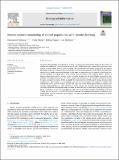Passive acoustic monitoring of animal populations with transfer learning
Abstract
Progress in deep learning, more specifically in using convolutional neural networks (CNNs) for the creation of classification models, has been tremendous in recent years. Within bioacoustics research, there has been a large number of recent studies that use CNNs. Designing CNN architectures from scratch is non-trivial and requires knowledge of machine learning. Furthermore, hyper-parameter tuning associated with CNNs is extremely time consuming and requires expensive hardware. In this paper we assess whether it is possible to build good bioacoustic classifiers by adapting and re-using existing CNNs pre-trained on the ImageNet dataset – instead of designing them from scratch, a strategy known as transfer learning that has proved highly successful in other domains. This study is a first attempt to conduct a large-scale investigation on how transfer learning can be used for passive acoustic monitoring (PAM), to simplify the implementation of CNNs and the design decisions when creating them, and to remove time consuming hyper-parameter tuning phases. We compare 12 modern CNN architectures across 4 passive acoustic datasets that target calls of the Hainan gibbon Nomascus hainanus, the critically endangered black-and-white ruffed lemur Varecia variegata, the vulnerable Thyolo alethe Chamaetylas choloensis, and the Pin-tailed whydah Vidua macroura. We focus our work on data scarcity issues by training PAM binary classification models very small datasets, with as few as 25 verified examples. Our findings reveal that transfer learning can result in up to 82% F1 score while keeping CNN implementation details to a minimum, thus rendering this approach accessible, easier to design, and speeding up further vocalisation annotations to create PAM robust models.
Citation
Dufourq , E , Batist , C , Foquet , R & Durbach , I 2022 , ' Passive acoustic monitoring of animal populations with transfer learning ' , Ecological Informatics , vol. 70 , 101688 . https://doi.org/10.1016/j.ecoinf.2022.101688
Publication
Ecological Informatics
Status
Peer reviewed
ISSN
1574-9541Type
Journal article
Description
Funding: ED is supported by a research chairship from the African Institute for Mathematical Sciences South Africa. This work was carried out with the aid of a grant from the International Development Research Centre, Ottawa, Canada , www.idrc.ca, and with financial support from the Government of Canada, provided through Global Affairs Canada (GAC) , www.international.gc.ca . This work was supported by funding from Microsoft's AI for Earth program.Collections
Items in the St Andrews Research Repository are protected by copyright, with all rights reserved, unless otherwise indicated.

